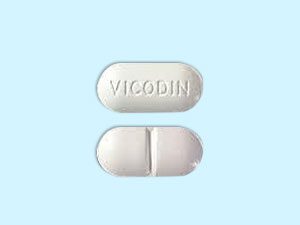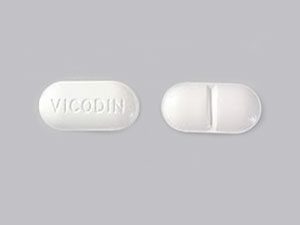Buy Vicodin Online
Showing all 2 resultsSorted by popularity
Vicodin is a brand-name drug combination of two prescriptions: hydrocodone (a narcotic analgesic drug) and acetaminophen (a non-narcotic analgesic drug). Vicodin is available in a generic form. Hydrocodone bitartrate and acetaminophen tablets are indicated for the management of severe pain to the point of needing narcotic pain relief and that lack the drug of choice. Vicodin drugs have become a popular choice of treatment among psychologists mainly because of their effectiveness in improving the levels of stress and satisfaction of a person in different situations.
What Does Vicodin Do?
Vicodin works by changing the way your brain responds to the sensation of torture. The pain reliever hydrocodone works by attaching to the spinal cord and narcotic receptors in the brain. This prevents pain signals from being sent out of the brain and reduces the pain sensation.
Another Vicodin ingredient, acetaminophen, is a non-narcotic analgesic that suppresses COX catalysts and prevents the synthesis of prostaglandins involved in pain and inflammation. Compared to hydrocodone, it provides more help with pain relief and control of unwanted effects. Combining a narcotic such as hydrocodone and a non-narcotic such as acetaminophen allows lower doses of each to be used, improving discomfort and reducing side effects.
What Is Vicodin Used For? Usages & Doses:
Vicodin can be used to treat post-menstrual pain, as well as for dental and other pain medications. It can help manage pain caused by an injury or severe injury. Medical professionals recommend this drug to treat the discomfort and pain that accompanies poor growth therapy. Vicodin also can reduce pain caused by chronic conditions such as back pain and joint pain. It can be considered a cough suppressant due to the presence of hydrocodone. Medical professionals may recommend this drug to treat certain types of neuropathic pain.
Vicodin dosage is available in pill form containing a combination of hydrocodone and acetaminophen. The most common dosages are:
-
10 mg hydrocodone / 300 mg acetaminophen
The recommended dosage schedule for Vicodin depends on the severity of the pain. For specific pain relief, the usual dose is one tablet every 4 to 6 hours, on a case-by-case basis. For severe pain, two tablets can be taken every four to six hours, depending on the condition.
The maximum daily dose is eight tablets (4000 mg acetaminophen) per day to prevent paracetamol poisoning. Extended-release plans are also available.
Vicodin is taken orally. The tablets must be completely consumed without being bitten or crushed. Vicodin pill provides rapid pain relief, with the onset of action 30 hours after oral intake.
Missed Dose Or Vicodin Overdose Symptoms:
If you miss a dose, take a regular dose at the next regular time, if necessary. Try not to eat more than the recommended doses
Take narcotic medications such as Vicodin (hydrocodone/acetaminophen) as prescribed. Taking more or more often than recommended can cause an overdose. In addition, it seems to be very dangerous if someone swallows the medicine. A Vicodin overdose can occur when someone takes more than the recommended or recommended amount. Symptoms of going too far can include:
-
Extreme drowsiness
-
Slowed or stopped breathing
-
Cold, moist skin
-
Pinpoint pupils
-
Loss of consciousness
-
Coma
The narcotic bandit naloxone is an attractive drug that can quickly reverse drug overdoses. It works by controlling narcotic receptors to deliver effects. Multiple doses of naloxone may be required if intravenous administration may be initiated.
After an overdose, continuous monitoring and regular clinical care are important. Supporting mental well-being can also help prevent future binge eating. Removing as much Vicodin from a person’s current condition can also help reduce the risk.
Vicodin Side-Effects:
Using Vicodin medication can cause some unwanted side effects. They are usually mild and disappear within a few days without treatment. Considering that you experience serious side effects of these drugs, you should seek medical help immediately. Some of the side effects of this medicine can be dangerous if not treated in time.
Common side effects:-
-
Obscured vision
-
Dry mouth
-
Irritated stomach
-
Constipation
-
Drowsiness
-
Brain pain
-
Nausea
-
Vomiting
-
Lightheadedness
-
Sedation
-
Euphoria
Serious side effects:-
-
Rest apnea
-
Breathing problems
-
Seizures
-
Loss of appetite
-
Too much fatigue
-
Hallucination
-
Allergic reaction
-
Inability to urinate
Interactions With Other Drugs:
White oval pill Vicodin can cause drug interactions with accompanying medications.
Try not to use Vicodin if you are taking monoamine oxidase inhibitors (MAOIs) (a class of antidepressants) or if you have stopped taking them more than 14 days ago. MAOIs include:
-
Emsam (selegiline)
-
Marplan (isocarboxazid)
-
methylene blue
-
Nardil (phenelzine)
-
Parnate (tranylcypromine)
-
Zyvox (linezolid)
Taking hydrocodone Vicodin with CNS depressants can cause extreme drowsiness, cognitive decline, breathing problems, extreme fatigue, and more. These include:
-
Alcohol
-
Barbiturates such as (Mysoline), pentobarbital, Sezaby (phenobarbital)
-
Other opioids
-
Narcotic hypnotics
Taking Vicodin at the same time as cytochrome P450 3A4 inhibitors (sedatives that block the movement of the CYP3A4 protein) can increase the amount of drugs in the blood. This can cause long-term or delayed effects, such as life-threatening breathing problems. Examples of these types of drugs are:
-
Antifungal drugs like ketoconazole
-
Other antimicrobials such as Biaxin XL (clarithromycin) and Ery-Tab (erythromycin)
-
Antiretroviral drugs for HIV, such as Reyataz (atazanavir) and Norvit (ritonavir)
Warning & Precautions:
Vicodin should be used with caution or avoided altogether in certain situations and populations:
-
People who have recently consumed drugs or alcoholic beverages. Vicodin is a big bet on trust and confidence. Those recovering from substance abuse problems have a greater chance of relapse if they take Vicodin.
-
Older patients. Vicodin is bound to cause agitation, excessive sleepiness, and breathing problems in older adults. Low percentages should be used.
-
Pregnant women. Vicodin can cause withdrawal effects in babies whenever it is taken late in pregnancy. Newborn babies can also have breathing problems if their mothers used Vicodin before giving birth.
-
Patients with head injury, brain enlargement, or increased intracranial tension. Vicodin can worsen this condition because of its effects on breathing.
-
Patients with liver or kidney disease. Vicodin is processed by the liver and metabolized by the kidneys, so poor functioning of these organs can lead to drug overdose and other side effects.
-
Patients with lung infections such as asthma or COPD. Vicodin can make breathing problems worse.
Storage & Disposal Of Vicodin Pill:
Vicodin should be stored at room temperature between 20°C and 25°C (68°F to 77°F).
Keep this medicine away from light. Store your Vicodin safely, with the cap in a safe place, away from children and expected guests at home.
Dispose of expired, unwanted, or unused Vicodin by flushing it completely or using a prescription refill option.
Alternatives:
Humira: Humira is a TNF-alpha inhibitor that can be used to treat a variety of inflammatory diseases, such as rheumatoid joint inflammation, psoriasis, ankylosing spondylitis, Crohn’s disease, and ulcerative colitis.
Methotrexate: Methotrexate can be considered for the treatment of psoriasis, rheumatoid joint inflammation, juvenile idiopathic polyarticular joint pain (pJIA), mycosis fungoides, and other diseases such as ZVO or non-Hodgkin’s lymphoma.
Tramadol: Tramadol has two different functions in the body. It is a narcotic painkiller, which means it binds to receptors in the brain to change one’s perception of pain. It also acts as a stimulant, increasing the activity of norepinephrine and serotonin in the brain.
Percocet: Percocet can help treat severe or temporary pain caused by a physical problem or medical procedure. The Percocet brand was more expensive than any other option. Vicodin was much cheaper than regular Percocet.
Frequently Asked Questions (FAQ)
Is Vicodin an opioid?
Yes, Vicodin is a combination drug that contains a narcotic called hydrocodone.
How long does Vicodin take to work?
Vicodin takes about 30 minutes to start work to relieve the pain.
Is Norco the same as Vicodin?
Norco and Vicodin are brand-name medications that contain two active ingredients: hydrocodone and acetaminophen. Both contain 5 mg, 7.5 mg, or 10 mg of hydrocodone. However, Vicodin and Norco have different doses of acetaminophen.
What does Vicodin look like?
The actual appearance of Vicodin and Vicodin shades is usually not surprising, they usually come in long or oval shapes and shades of white.


